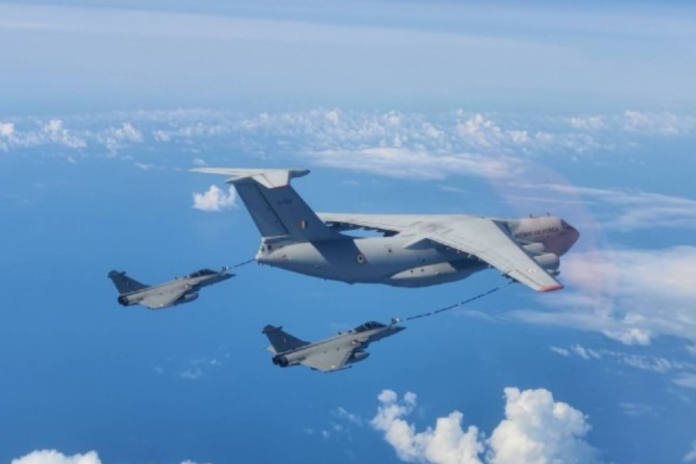On July 31, 2023, the Indian Air Force (IAF) held a press conference in New Delhi to officially launch “Tarang Shakti,” the Mother-of-all-Exercises. It’s the biggest global air exercise that India has ever seen.
In actuality, “Exercise Shiksha,” which took place in 1963 following the 1962 conflict with China, was the final multilateral exercise in India involving multiple foreign air forces. The air forces of the United States, United Kingdom, and Australia were involved in that one. The IAF invited 51 friendly foreign nations to Tarang Shakti.
The Indian Air Force (IAF) stated in a briefing that was presided over by Vice Chief of Air Staff Air Marshal AP Singh that the objectives were to improve mutual knowledge of air power, conduct realistic operations, fortify military connections, and exhibit indigenous defence assets.
Tarang Shakti was originally scheduled to take place in late 2023, however it was postponed. There are two stages to the exercise schedule.
It would be convenient for the majority of these nations to participate in the first phase of Exercise “Pitch Black” while returning from Australia. Phase I will include the MiG-29K aircraft of the Indian Navy. LCA “Tejas” has its home base at Sulur.
After Hindon, this former Indian Navy and Royal Navy post is the country’s second-largest airbase. It is among the bases in charge of defending India from the coast.
It’s one of the few air bases in India where you can find helicopters, transports, and fighters all in one place. At this airbase, the Indian Navy created INS Hansa to operate Hawker Sea Hawks after attaining independence. Following Goa’s liberation, the Indian Air Force (IAF) assumed control of Sulur and moved INS Hansa to the Dabolim airport in Goa.
The Indian Air Force’s 43 Wing and 5 site Repair Depot are located on the site. Additionally, a Mi-17 V5 transport helicopter unit and an Antonov An-32 medium transport aircraft squadron are housed there. There’s also the home base for the Sarang helicopter display team. In July 2018, it was adopted as the foundation for LCA Tejas.
The slightly larger Phase-II will be at AF Station Jodhpur, Rajasthan, from August 29 to September 14, 24 after a two-week break. Along with 18 other countries as observers, it will feature Australia, Bangladesh, Singapore, Greece, the United Arab Emirates, and the USA.
In the 1920s, Maharaja Umaid Singh founded the Jodhpur Flying Club at a tiny airstrip next to his Chittar Palace (Umaid Bhavan Palace) in Jodhpur. The airfield gained prominence during the ensuing three decades and saw use by the Royal Air Force (RAF) in World War II.
Following the establishment of the Royal Indian Air Force (later renamed the Indian Air Force), it was modified in 1950. The IAF’s Air Force Flying College was located at Jodhpur till the war in 1965.
It is one of main air stations of the IAF in the desert region and was crucial to operations during the wars of 1965 and 1971 between India and Pakistan. Throughout the years, numerous elite IAF aircraft had called it home. The Indigenous HF-24 “Marut,” the Mikoyan MiG-23 BN, the MiG-27, the Sukhoi Su-30MKI, the HAL Dhruv, the Mil Mi-17, and the first Indigenous LCH “Prachand” base were all housed there. The French Air and Space Force (FASF) and the US Air Force (USAF) participated in the “Garuda” series of air exercises at the airbase, and more recently, Oman participated in air exercises.
Australia is invited, having hosted the just concluded “Pitch Black” exercise. The following countries in alphabetical order received invitations from Africa: Algeria, Angola, Botswana, Ethiopia, Egypt, Ivory Coast, Kenya, Morocco, Mozambique, Nigeria, South Africa, Tanzania, and Tunisia.
Nations participating from Asia included the following countries: Republic of Korea (RoK), Saudi Arabia, Singapore, Sri Lanka, Tajikistan, Thailand, Turkmenistan, UAE, Uzbekistan, Vietnam, and Bangladesh, Brunei, Cambodia, Indonesia, Japan, Kazakhstan, Kyrgyzstan, Laos, Malaysia, Maldives, Nepal, Oman, Philippines, and Vietnam.
Europe sent invitations to France, Germany, Greece, Italy, Spain, Sweden, and the United Kingdom. America is the only nation in North America. South America is home to Argentina, Brazil, Chile, Colombia, and Venezuela. It is evident that, despite Russia’s invitation, India’s major military equipment partners, Israel and Russia, are not included on the list. Currently, both are involved in



